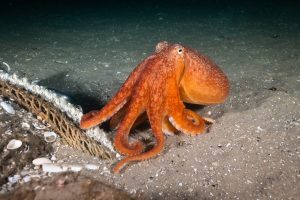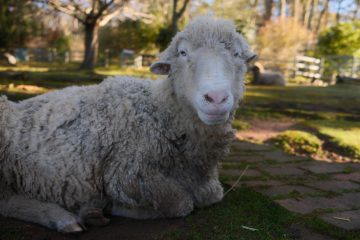Doggerland Entanglements

Imagine that the land between Great Britain, Denmark, Germany, and the Netherlands was not covered by water. Instead, it consisted of a landscape rich in plant, animal, and fungi life with hills and rivers, making it an ideal habitat for hunter-gatherer-fisher communities (human and nonhuman). The waters of the Rhine, Scheldt, and Thames had not yet merged to form the English Channel and separate Great Britain from the rest of Europe. You could travel long distances by boat, from Central Europe to the Orkney Islands and Scandinavia.
What sounds like a fairy tale is, in fact, an integral part of European heritage. I’m talking about the Dogger Bank, a massive undersea sandbank located in the heart of the North Sea. It covers almost 25,000 square kilometers and is about 260 by 100 kilometers in extent. The term has been used in several European languages and refers to 17th-century Dutch fishing boats called “doggers.”
Following the Last Glacial Period (approximately 115,000 to 11,000 years ago), a large, inhabitable landmass formed. Prehistoric archaeologist Bryony Coles coined the term “Doggerland” for this region in the 1990s. Early hominids left the first footprints in northern Europe in this land more than 900,000 years ago. For hundreds of thousands of years, the land was exposed to ice ages—a world inhabited by woolly mammoths, rhinoceroses, horses, and reindeer, as well as the Neanderthals who lived there for many years. One of these Neanderthals was Krijn, the first Neanderthal from Doggerland (and supposedly the first “Dutch” ancestor to be identified), who lived about 40,000 years ago. Between 10,000 and 7,000 years ago, rising sea levels inundated Doggerland, initially disintegrating it into a series of low-lying islands before it submerged completely. The Storegga underwater landslide, which occurred around 8,200 years ago, generated a tsunami that had a significant impact on the future of Doggerland.
As Luc Amkreutz and Sasja van der Vaart-Verschoof rightly emphasize, it is important to tell the story of Doggerland. Doggerland is not just about European history and heritage. Rather, it is a prime example of the entanglements of many kinds: between past and present, between human and nonhuman, between nature and culture, and between science and mythology.
To begin with, many recent archaeological findings are the result of extractive capitalist activities. For example, ancient artifacts were brought up when the soil of the North Sea was dredged. The Dogger Bank is also home to the world’s largest offshore windfarm because its shallow waters are ideal for traditional fixed-foundation wind turbine designs. However, this has sparked environmental protests from many countries, as the Dogger Bank is at the heart of a network of marine protected areas (MPAs) that are necessary to restore the North Sea ecosystem. Biologists call the Dogger Bank the nursery of the North Sea.
The Dogger Bank entangles the past and the present. There is much to learn from how these landscapes, including the humans who lived there for thousands of years, adapted to massive climate and environmental changes. Based on rituals reconstructed from archaeological evidence, we can assume that people of that time identified with the land. In Alistair Moffat’s words: “They were buried inside it and it was inside them, indivisible” (p. 80, 2005 edition). When did we lose this connection, and can it be restored?
Questions like these are at the core of our current environmental, political, philosophical, and emotional situation. To create a space where the complex conversation can find a home, the School of Dogger Bank was founded. Through this initiative, the Doggerland Foundation and the Embassy of the North Sea are collaborating with a broad network of Dutch and European partners, including ecologists, policymakers, lawyers, artists, and designers, to advocate for the Dogger Bank. This was also formulated programmatically in a Manifesto titled “Making Room for the Dogger Bank.” This important initiative has a clear goal:
Despite the physical and political inaccessibility of the Dogger Bank, our lives are intertwined with the Dogger Bank and the North Sea in countless ways. School of Dogger Bank invites creative professionals to offer unconventional perspectives and design solutions at various scales to see the Dogger Bank as a political (legal) person and to strengthen its position at the cultural, political and legal negotiating table.
In five working groups, the School of Dogger Bank looks at Worldview & Mythology (I’m happy to be part of that working group myself), North Sea Politics & Policy, Landscape & Public Space, Reef Restoration, and a Law Clinic.
In my view, this work is a prime example of how planetary knowledge can emerge—a kind of knowledge that respects the integrity of nonhuman entities and engages with ecologies of agency in a non-invasive way.
Currently, we are preparing the third edition of the Confluence of European Water Bodies that will take place in the Netherlands from 21–25 September 2025. Two years ago, our growing community of over 25 seas, rivers, lakes, glaciers, and lagoons converged for the first time at the shores of the Mar Menor saltwater lagoon in Spain. As the first European ecosystem to be granted legal personhood, this severely contaminated ecosystem has become an example and inspiration for ecological protection in Europe. The Confluence 2024 took place on the shores of the Venice Lagoon.
At the 2025 edition on the shores of the North Sea, we will honor the long and changing lives of the North Sea, but also of the rivers Rhine, Scheldt, and Thames, which once formed the Doggerland landscape.
#
Kocku von Stuckrad is one of the co-founders and co-directors of Counterpoint: Navigating Knowledge. As a Professor of Religious Studies at the University of Groningen (Netherlands), he works on the history of religion, science, and philosophy in Europe and North America. His most recent books are Nach der Ausbeutung: Wie unser Verhältnis zur Erde gelingen kann (Europa Verlag; English translation in preparation with Equinox Press) and A Cultural History of the Soul: Europe and North America from 1870 to the Present (Columbia University Press).
Counterpoint blogs may be reprinted with the following acknowledgement: “This article was published by Counterpoint Navigating Knowledge on 10 June 2025.” The views and opinions expressed on this website, in its publications, and in comments made in response to the site and publications are those of the author(s) and do not necessarily reflect the views and opinions of Counterpoint: Navigating Knowledge, its founders, its staff, or any agent or institution affiliated with it, nor those of the institution(s) with which the author is affiliated. Counterpoint exists to promote vigorous debate within and across knowledge systems and therefore publishes a wide variety of views and opinions in the interests of open conversation and dialogue.
Photo credits: “Octopus” © Joost van Uffelen, downloaded from Embassy of the North Sea website.



